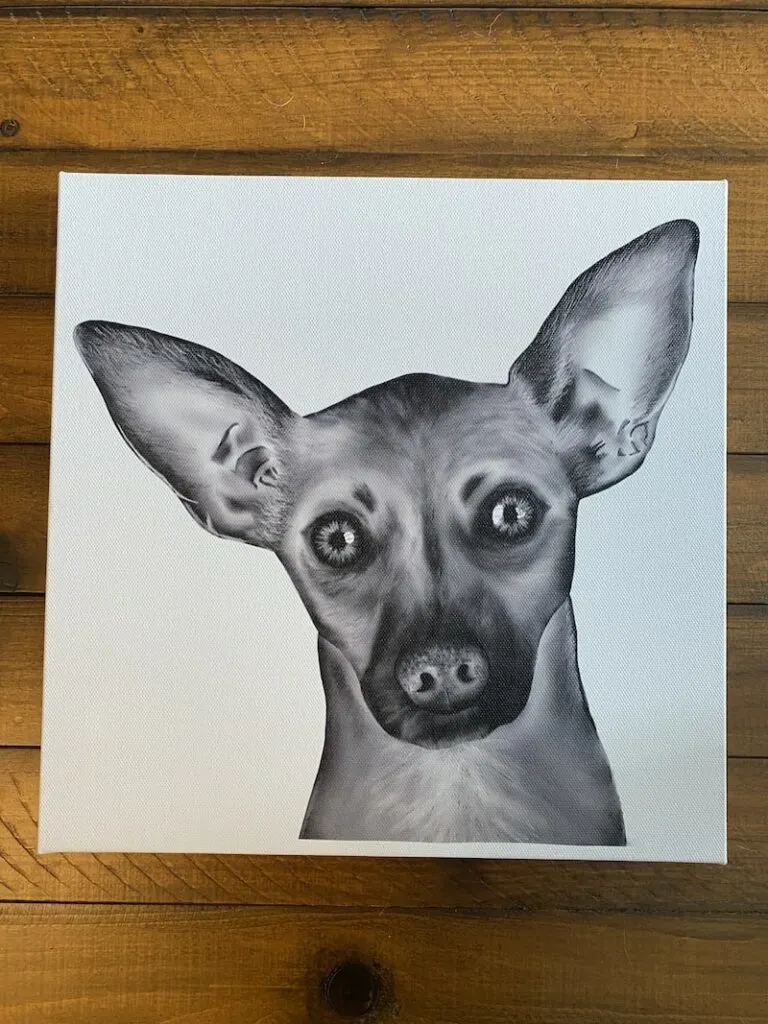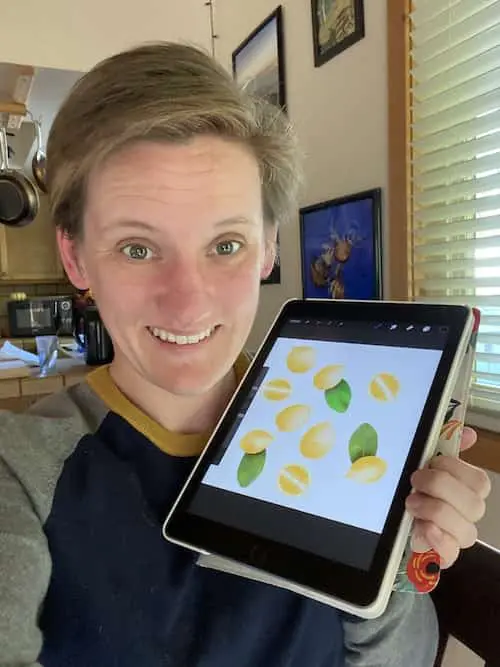When you’re getting started with selling art, all of the choices can be overwhelming. Where do you sell? How do you sell? What can you sell? One of the most fundamental questions that you need to answer first is: will you be selling original art, or prints? This is a really important question and, if you need to answer it before even posting your first listing.
Selling original art is great if you are targeting art collectors, investors, museums, or galleries. Art prints make sense if you plan to sell your art to a large audience, in large volumes. Prints are well suited for online platforms like Etsy, or in person venues like farmer’s markets or craft fairs.
Deciding whether you should be selling original art vs. prints can shape the direction of your art selling career. It will fundamentally change your audience, production strategy and overall focus.
That’s not to say you can’t do both, which we’ll talk about at the end of this post. To begin with though, let’s talk about the details of selling original art vs. prints so that you can fully understand the benefits and ramifications of both.
Selling Original Art
When you sell original art, you create one piece of artwork that is sold once. For most artists, this means that no copies are made of that piece of artwork. The purchaser is the only one who owns any version of that piece of art. It’s an original.
When you sell original art, it has a higher value than a print. It’s unique and buyers will pay more for the exclusivity of being the only one to own that piece of work.
This makes sense when you think about the audience that typically buys original art. Art collectors, galleries, and museums pride themselves on having unique art collections that can either be resold, or appreciate in value overtime.
If thousands of copies of the art exist, it usually isn’t as interesting or valuable. Which leads us to our next point.
To understand it in a different way, let’s put ourselves in the shoes of the buyers of original art for a second.
Why you should buy original art?
Given that it’s one of a kind, original art has a higher value than art that is created in large quantities as prints. Art galleries purchase original art in order to resell it. Art collectors hope that original art increases in value and can be treated as an investment.
Let’s say that you own an art gallery. You purchase original art with a focus on reselling it. The first priority is that you recoup your costs from purchasing and marketing each piece of artwork. The second priority, ideally, is that you make a profit.
Buying originals, you know that your customers won’t find the same work anywhere else. This allows you to price it higher and gives your customers an incentive to buy from you. I mean, they won’t find that art anywhere else!
Let’s say that you source art for a museum. You know that your attendees expect to see art and collectibles that they have never seen before and will never see anywhere else. Why would they go to a museum otherwise? Finding an original art that fits within a certain exhibit is like finding a needle in a haystack, which increases its value and price.
Let’s say you’re an art collector. You pride yourself on the unique collection of art that you own and you also see it as a monetary investment. You hope that the art will appreciate overtime and contribute substantially to your net worth.
Now that we understand the major players who typically purchase original art, we need to talk about the caution you need to take about selling prints along with your originals.
Why you need to be careful about selling prints when you sell original art
For everyday artists, the value comes with selling a one-of-a- kind piece of work that no one else has.
When artists become extremely famous, that can change. It’s common for prints to be sold in addition to the originals. The artist is so incredibly famous and the originals are worth so incredibly much that owning an original is a signal of high status, regardless of whether prints of that work exist.
If that’s confusing, let’s look at an example.
In 2010, one of Pablo Picasso’s original works became the most expensive pieces of art ever sold at auction (source). Nude, Green Leaves and Bust sold for a mindblowing $106,482,500 (source). Yet, you can buy a print of this work for less than $30.
Nude, Green Leaves and Bust, 1932, Pablo Picasso pic.twitter.com/GUMAISxdhv— Olga Tuleninova 🦋 (@olgatuleninova) July 26, 2020
As far as Picasso is concerned, there’s a HUGE price difference between his original works and his prints. If the owner of the $106,482,500 version and the $30 version stood next to each other, there would be no doubt that the one who shelled out many millions of dollars had the more valuable version. It’s monetary value is 3,549,416 times that of the prints.
But, whether we like it or not, many of us aren’t Picasso and never will be. Let’s say that you sell an original for $4,000. Before you sold it, you made some prints and sold them for $30. In this case, your original is only worth 133 times that of the prints.
Depending on who you sell the original to, the fact that prints exist could devalue the original enough to make it an unappealing purchase.
Here’s another example. There’s a gallery in Lake Tahoe that features the work of Dr. Seuss. I could head to the children’s section of the library and pick up a ratty copy of a Dr. Seuss book and see the same thing. But, the experience isn’t the same at all.
No, what’s neat about the gallery is that you see limited editions and originals. It’s a whole other world.
We’ll talk about this more in the last section about selling both prints and originals.
Your Focus as an Artist When Selling Originals
When you sell original work to galleries and museums, you want to make sure to do a lot of research. You only get to sell each piece of work once, so you better do your due diligence to make your artistic efforts worth it.
Sometimes, this doesn’t mean getting the right price. If the Metropolitan Museum of Art wants to feature my work, heck I’ll pay THEM to put my artwork in the downstairs bathroom, let alone sell it to them to be featured in a main exhibit.
You need to understand where you are in your art journey. Are you still establishing yourself and willing to sacrifice a few dollars for more exposure? Are you an established artist with a strong reputation who now is more selective and looking for the highest price?
Decide what you’re looking for. This will make your selling experience MUCH easier.
Once you understand what you want as an artist selling original work, it’s time to identify WHO and WHERE you want to sell to. Scan through some galleries and museums while keeping the following in mind.
1. Have they taken work like mine before?
If you create portrait photography, you might not have a lot of luck selling to galleries or museums that primarily focus on acrylic landscapes. If your art is edgy and modern, you might not have luck selling to galleries or museums that focus on classic and historical work.
Find the right fit for your art, stylistically.
2. Understand the rules and procedures
All galleries and museums have rules and procedures around how they curate and purchase artwork. Following these rules is not only important for making sure that your artwork makes it through the first screening process, but it can also verify that your art is a good fit.
Let’s look at the rules for the Oakland Museum of California. Even a quick glance will tell you that they prefer artwork and/or artists that have a connection form California. If you’re an East Coast artist promoting a painting of NYC, you might be out of luck. The rules also clearly lay out the information you need to include when contacting the museum about your work. If you don’t include this info, it’s unlikely you’ll be noticed (source).
Understand what the gallery, museum, or art collector wants, expects, and needs from an art purchase. This will give you a huge leg up when approaching them and could be the difference between making a sale and not making a sale.
Selling Prints
When you sell prints of your art, you open yourself up to a wider audience of buyers. You also need to price your art lower. For prints, selling each copy for many thousands of dollars isn’t going to work. If you sell a lot of prints though, this can add up to as much, or more, than an original.
I personally create a lot of digital art that I make prints of.

To understand it in a different way, let’s put ourselves in the shoes of the buyers of original art for a second.
Why you should buy prints of art?
If you’re like me, you enjoy art, but you aren’t a curator for a gallery or a museum. You also aren’t rolling in millions of extra dollars, which means you aren’t an art collector, or you only dabble in it with lower priced art.
Instead, you buy art that you enjoy and can afford. Usually, this means you buy prints.
Maybe you moved into a new apartment and have extra wall space. You browse Amazon to see which art appeals to you, is within your budget, and comes with free shipping.
Maybe you’re at a farmer’s market or craft fair and there’s a booth that catches your eye. You start chatting with the artist and really jive with their personality and style. You want to support them and concede that there’s a print in your living room that could do with some refreshment. You pick out a nice print and replace the stale one in your living room.
Here are the huge differences between buyers of original art and the buyers of prints summed up:
Originals: investment-focused with an eye for future profit
Prints: budget-focused with an eye for maximum enjoyment
Ok, now that we’ve understood the buyers of prints, let’s talk about what it means for you as a seller.
Are art prints worth anything?
When you sell prints, it’s unlikely that they’ll be worth anything beyond that first sale. They are meant to be sold in mass, appreciated by the buyer, but not resold again. This is different from original pieces of art that appreciate in value overtime.
There’s an exception here though: limited edition prints
Limited edition prints are prints that are produced in a small quantity. This increases their value because, given they aren’t mass produced, there are only a few copies to go around. Limited edition prints can be sold for a few hundred to a few thousand dollars depending on the fame of the artist and the number of prints that are made.
Unlike typical prints that are produced in unlimited quantities, limited edition prints can be resold given that they become more and more rare as time goes on.
Your Focus as an Artist When Selling Prints
A LOT of artists sell prints and a LOT of artists make a LOT of money selling prints. The key words here are, “a lot.” Obviously, you’ll make more money selling an original piece of art for $4,000 than a print for $30.
But, what if you sell that $30 print again and again and again? It won’t take long before your profit is above the $4,000 you would have made from selling it as an original. When you sell prints, your profit is potentially unlimited.
When you sell prints, you need to focus on volume.
Build a social media presence, start an Etsy store, go to farmer’s markets and craft fairs, spread the word to friends and family.
If you’re thinking that this all sounds great, but how the heck are you going to deal with printing and packaging SO many prints? Well, I have a solution for you.
A lot of print on demand platforms integrate with Etsy, which makes it quick and easy to fulfill your orders when they come through.
Selling Original Art and Prints at the Same Time
If you’ve read up until this point, it’s pretty clear that selling both prints and originals doesn’t usually work. It’s tricky, to be sure. If you want to go down this road, the first thing you’ll want to do is thoroughly understand the rules of the museums and galleries you’re hoping to target.
What are their feelings about originals that have had prints made of them? What price cut could you be facing?
It’s highly unlikely that you could sell an original while also selling prints at the same time. At the very least, you’d have to discontinue your prints.
Honestly, this is pretty sticky and I wouldn’t encourage it.
But, you CAN sell originals of some work while selling prints of another. If you have a large collection of art, there’s no reason why you can’t have some pieces that you sell prints of and others that are reserved to be sold as originals. This can give you the best of both worlds without breaking any rules or getting into tricky territory.
When you get started with selling your art, there’s no doubt that you’ll run into the question of selling originals vs. prints very very quickly. It’s likely the first question you’ll run into. As long as you do your research and have a clear idea of what you want from your art selling career, you’ll be in a great place to get started.

Diana has been an artist for over 27 years and has training in drawing, painting, digital drawing and graphic design. Diana’s latest obsession is digitally drawing with Procreate and Procreate Dreams. Diana has experience selling her art across a number of platforms and loves helping other artists learn how to make money from their art as well.
